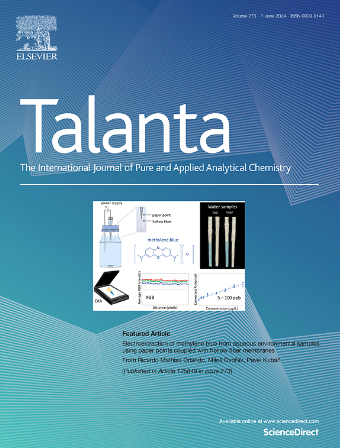A new ternary deep eutectic solvent for electropolymerization of thionine on glassy carbon electrodes modified with multiwalled carbon nanotubes for the determination of ascorbic acid
IF 5.6
1区 化学
Q1 CHEMISTRY, ANALYTICAL
引用次数: 0
Abstract
The phenazine redox dye, thionine (Th), was used to prepare poly(thionine) (PTh) polymer film modified electrodes. PTh was electrodeposited on glassy carbon electrodes (GCE) and on GCE modified with multiwalled carbon nanotubes (MWCNT) by potential cycling electropolymerization in the ternary deep eutectic solvent composed of choline chloride (ChCl), thymol (Thy), ethylene glycol (EG), ChCl-Thy-EG (1:1:4) with the addition of different doping acids. The MWCNT promote greater polymer growth, conductivity and increased stability of the polymer films. The modified electrodes, PTh/MWCNT/GCE, were characterized by cyclic voltammetry, electrochemical impedance spectroscopy and the morphology of its surface by scanning electron microscopy. PTh/MWCNT/GCE was used in the determination of ascorbic acid (AA) using fixed potential amperometry with a linear range of 2.5 μM–100 μM and a detection limit of 0.68 μM. The proposed sensor was tested on commercial pharmaceutical samples successfully with good sensitivity, repeatability and reproducibility.

求助全文
约1分钟内获得全文
求助全文
来源期刊

Talanta
化学-分析化学
CiteScore
12.30
自引率
4.90%
发文量
861
审稿时长
29 days
期刊介绍:
Talanta provides a forum for the publication of original research papers, short communications, and critical reviews in all branches of pure and applied analytical chemistry. Papers are evaluated based on established guidelines, including the fundamental nature of the study, scientific novelty, substantial improvement or advantage over existing technology or methods, and demonstrated analytical applicability. Original research papers on fundamental studies, and on novel sensor and instrumentation developments, are encouraged. Novel or improved applications in areas such as clinical and biological chemistry, environmental analysis, geochemistry, materials science and engineering, and analytical platforms for omics development are welcome.
Analytical performance of methods should be determined, including interference and matrix effects, and methods should be validated by comparison with a standard method, or analysis of a certified reference material. Simple spiking recoveries may not be sufficient. The developed method should especially comprise information on selectivity, sensitivity, detection limits, accuracy, and reliability. However, applying official validation or robustness studies to a routine method or technique does not necessarily constitute novelty. Proper statistical treatment of the data should be provided. Relevant literature should be cited, including related publications by the authors, and authors should discuss how their proposed methodology compares with previously reported methods.
 求助内容:
求助内容: 应助结果提醒方式:
应助结果提醒方式:


